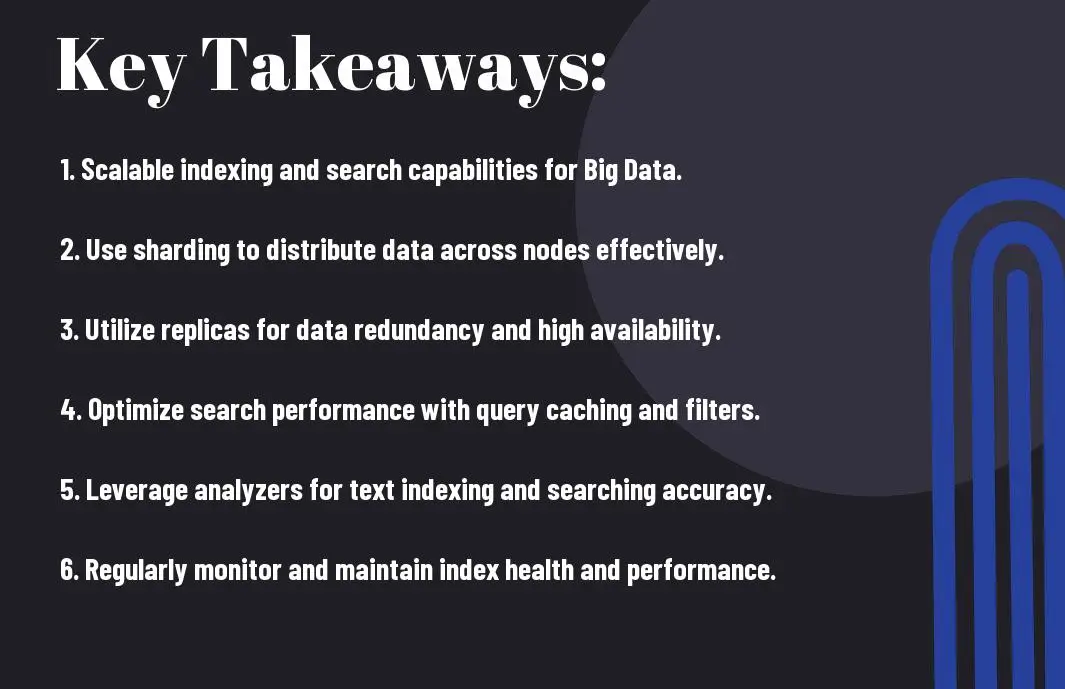Many data enthusiasts and professionals find themselves in a labyrinth of information overload when dealing with Big Data. Fear not, for Elasticsearch is here to solve the puzzle. In this guide, we will unravel the mysteries of indexing and searching through vast volumes of data using Elasticsearch. Prepare to unlock the power of real-time search and deep insights with the help of this revolutionary tool. Let’s probe the world of Elasticsearch and conquer Big Data indexing and searching.

What is Big Data?
Definition and Characteristics
To understand Big Data, we must first acknowledge its vastness in volume, velocity, and variety. Any dataset that is too large and complex for traditional data processing applications to handle qualifies as Big Data. This could include data from diverse sources such as social media, sensor networks, or e-commerce transactions. The three main characteristics that define Big Data are volume, velocity, and variety.
Importance in Modern Business
Definition Concerning modern business operations, the significance of Big Data cannot be overstated. For instance, companies can leverage Big Data to gain valuable insights into consumer behavior, market trends, and operational efficiencies. By analyzing large datasets in real-time, organizations can make data-driven decisions that drive innovation, improve customer experiences, and stay ahead of the competition.
Over time, as our data grows exponentially, the need for efficient indexing and searching mechanisms becomes imperative. In this comprehensive guide, we research into the world of Elasticsearch – a powerful tool designed to handle Big Data with ease and precision. Learn how to index massive amounts of data swiftly and search through it seamlessly using Elasticsearch’s robust features. Harness the capability of Elasticsearch to tame your Big Data beast efficiently.
Preparing Big Data for Indexing
Data Ingestion Methods
Your journey to index and search big data using Elasticsearch begins with the crucial step of ingesting data. There are various methods for data ingestion, including batch processing, stream processing, and real-time ingestion.
Data Processing and Transformation
Data processing and transformation are imperative steps in preparing big data for indexing. This involves cleaning up data, transforming it into a suitable format, and enriching it with additional information to make it more searchable.
This step ensures that the data is structured properly and optimized for efficient querying in Elasticsearch. It also involves handling any data quality issues and outliers that may affect the indexing and search process.
Data Quality and Cleaning
Ingestion of dirty or inconsistent data can lead to inaccurate search results and poor performance. It is important to address data quality issues by cleaning and standardizing the data before indexing it in Elasticsearch.
Another important aspect of data quality is ensuring that the data is consistent, complete, and free from errors. Tools like Elasticsearch’s ingest nodes and pipelines can be used to perform data cleaning tasks such as data deduplication, normalization, and validation.
Indexing Big Data with Elasticsearch
Creating an Index
With Elasticsearch, indexing big data involves creating an index that serves as a logical namespace to organize the data. An index in Elasticsearch is similar to a database in SQL, and it stores a collection of documents that share similar characteristics or properties. To create an index, you can use the PUT method in Elasticsearch’s RESTful API, specifying the name of the index and any relevant settings.
Mapping Data Types
With Elasticsearch, mapping data types define the characteristics of fields within documents stored in an index. By specifying the mapping, you can control how Elasticsearch interprets and indexes the data, optimizing search performance. When mapping data types, some common ones to consider include
- text: for full-text search,
- keyword: for exact matching, and
- date: for date values.
After defining the mapping, Elasticsearch will dynamically apply it to incoming data for consistent indexing and searching.
Optimizing Indexing Performance
Data optimization in Elasticsearch involves strategies to enhance the indexing process for better performance with big data. By configuring settings like bulk indexing, tuning refresh intervals, and utilizing index aliases, you can optimize the indexing process for efficiency and speed. Proper data optimization can significantly improve indexing speed and resource utilization, ensuring optimal performance for searching and querying large datasets.

Searching Big Data with Elasticsearch
Many organizations are turning to Elasticsearch to search through vast amounts of Big Data. This powerful search and analytics engine allows users to query and retrieve data quickly and efficiently. In the world of Big Data, the ability to search through massive datasets is crucial for extracting valuable insights and making informed decisions.
Query Types and Syntax
Any search in Elasticsearch begins with a query, which specifies the criteria for retrieving results. There are different types of queries that can be used, such as match, term, range, and more. Each query type has its own syntax and parameters that allow users to fine-tune their searches according to specific requirements.
Importantly, mastering the syntax of Elasticsearch queries is imperative for effectively searching through Big Data. The table below outlines some common query types and their syntax for reference.
| Query Type | Syntax |
| Match | GET /_search?q= |
| Term | GET /_search { “query”: { “term” : { “” : “” } } } |
| Range | GET /_search { “query”: { “range” : { “” : { “gte” : “” } } } } |
| Bool | GET /_search { “query”: { “bool”: { “must” : { }, “filter” : { } } } } |
| Wildcard | GET /_search { “query”: { “wildcard” : { “” : “*” } } } |
Thou must pay attention to the syntax and parameters of each query type to construct effective search queries that yield relevant results.
Search APIs and Parameters
Any search operation in Elasticsearch is carried out using Search APIs, which allow users to interact with the search engine and retrieve the desired information. These APIs provide a range of parameters that can be used to customize search queries and control search behavior.
Syntax highlighting, auto-complete, and contextual suggestions are some of the features that can be integrated with Elasticsearch to enhance the search experience for users. By leveraging these parameters, organizations can optimize their search capabilities and extract valuable insights from their Big Data repositories.
Handling Search Results
With Elasticsearch, handling search results efficiently is crucial for extracting meaningful information from Big Data. After executing a search query, the returned results need to be parsed, analyzed, and presented in a clear format for users to interpret.
Handling search results also involves implementing facets, aggregations, and sorting to organize and filter the data effectively. By mastering the techniques for handling search results, organizations can unlock the full potential of their Big Data and gain valuable insights for decision-making.
Advanced Elasticsearch Features
Keep your search capabilities at the cutting edge by exploring the advanced features of Elasticsearch. Below are some features that will help you make the most of your big data indexing and searching:
- Aggregations and Grouping
- Filtering and Faceting
- Scripting and Customization
Aggregations and Grouping
On Aggregations and Grouping, Elasticsearch offers powerful capabilities to analyze and summarize your data. By using aggregations, you can group and categorize data based on specific criteria. This feature is invaluable for generating insights and visualizations from your big data.
| Aggregations | Grouping |
| Perform complex calculations | Categorize data based on criteria |
| Generate statistical summaries | Create structured views of data |
Filtering and Faceting
Faceting in Elasticsearch allows you to categorize search results into different facets, making it easier to navigate through large datasets and narrow down results. With filtering, you can refine search queries by applying specific criteria. This enhances the precision and relevance of search results.
It enables users to drill down into data, uncover hidden patterns, and gain deeper insights. By combining filtering and faceting, you can efficiently explore and analyze your big data, making Elasticsearch a powerful tool for data exploration and discovery.
Scripting and Customization
On Scripting and Customization, Elasticsearch provides the flexibility to tailor your search queries and data processing using scripts. This feature allows you to customize scoring, sorting, and data transformations to meet your specific requirements. With scripting, you can fine-tune Elasticsearch to address unique use cases and business needs.
Grouping the data based on custom criteria provides a more granular view of your big data, enabling targeted analysis and insights. Scripting and customization empower you to harness the full potential of Elasticsearch and extract maximum value from your big data repositories.
Summing up
With the exponential growth of big data, managing and querying large datasets efficiently has become a crucial task for businesses. Elasticsearch offers a robust solution to index and search big data, providing fast and scalable search capabilities. By following the steps outlined in this guide, you can leverage Elasticsearch to organize, index, and search your vast amounts of data effectively.
Understanding the key concepts of indexing, mapping, querying, and optimization in Elasticsearch is crucial for unlocking its full potential in handling big data. By mastering these fundamentals and exploring the advanced features of Elasticsearch, you can streamline your data management processes and extract valuable insights from your massive datasets with ease.
FAQ
Q: What is Elasticsearch and how does it help in indexing and searching Big Data?
A: Elasticsearch is a distributed, RESTful search and analytics engine designed for horizontal scalability, reliability, and real-time search. It allows you to store, search, and analyze big volumes of data quickly and in near real-time.
Q: How can I index data in Elasticsearch for efficient searching?
A: To index data in Elasticsearch, you first define an index, which is like a database in relational databases. You then define a mapping which determines how documents and their fields are stored and indexed. Finally, you can use APIs to add or update documents in the index for searching.
Q: What are some best practices for optimizing search performance in Elasticsearch with Big Data?
A: To optimize search performance in Elasticsearch with Big Data, consider factors like sharding, replication, and query optimization. Use appropriate mappings, leverage filters for faster search, and consider using aliases for flexibility in searching. Regularly monitor cluster health and performance for continuous optimization.




